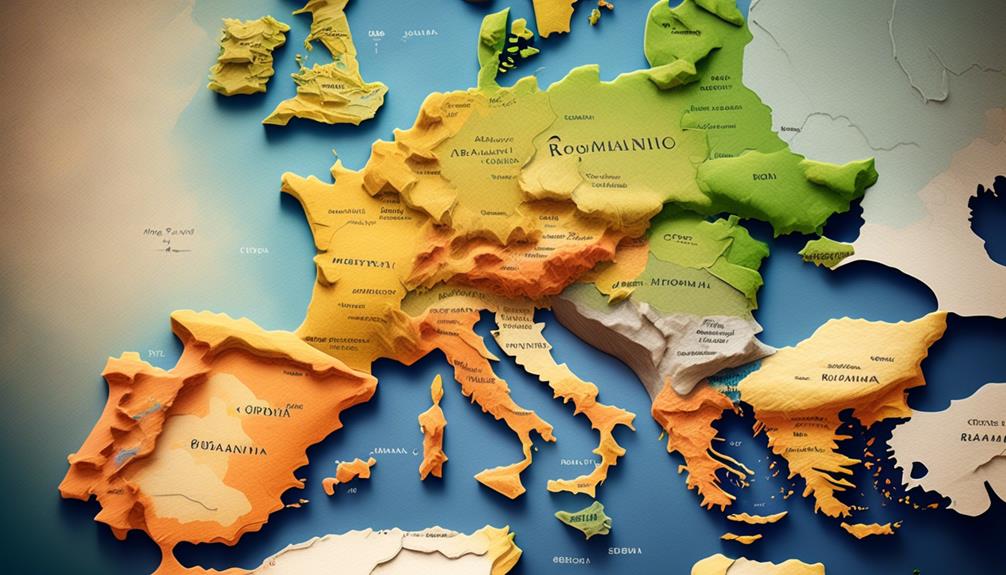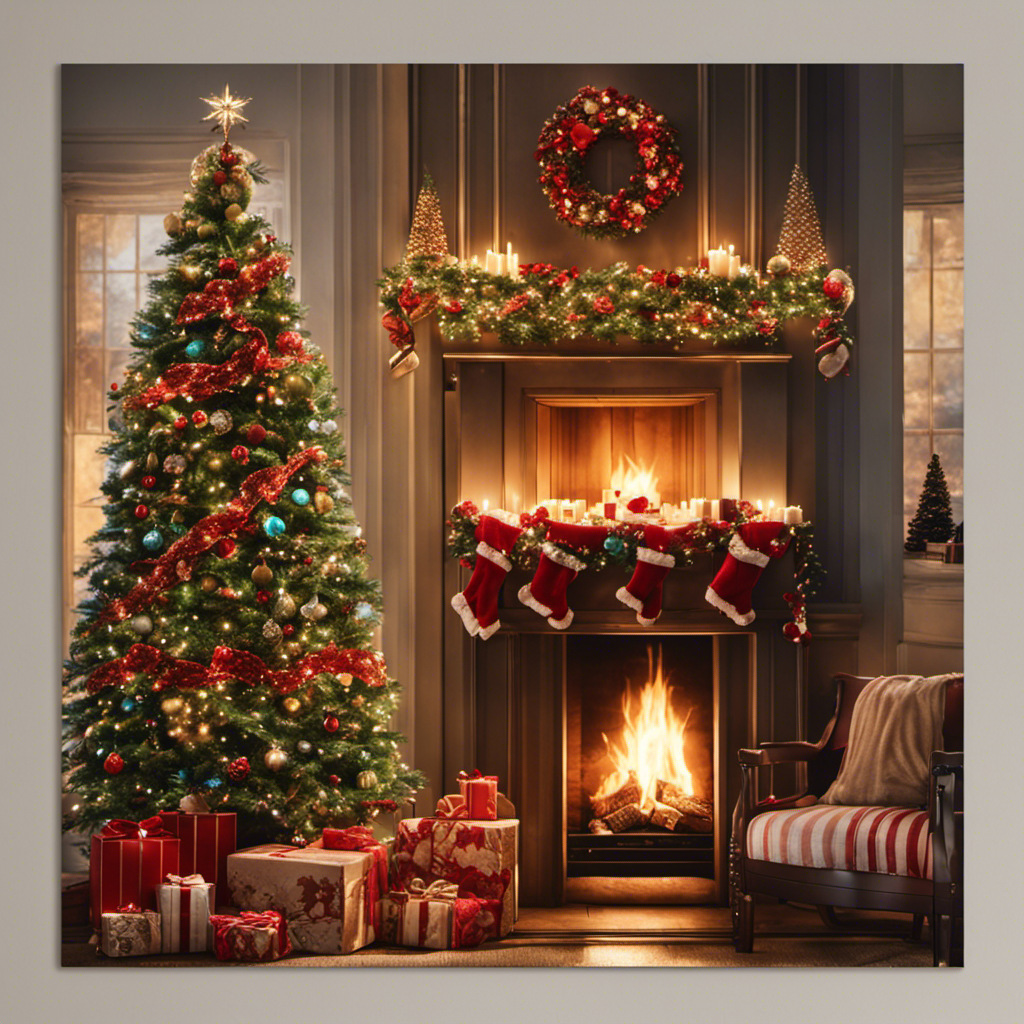Christmas Decoration
Which Countries Are Orthodox?
2025

Have you ever pondered the global distribution of Orthodox Christianity?
From its roots in the Eastern Roman Empire to its presence in various continents, the Orthodox faith has had a significant impact on the cultural and religious landscape of numerous countries.
As you explore the historical and contemporary context of Orthodoxy, you'll gain insight into the diverse nations that have embraced this rich religious tradition.
Key Takeaways
- The Byzantine Empire played a pivotal role in the spread of Orthodox Christianity.
- Greece, Russia, Serbia, Romania, Bulgaria, and Cyprus have significant Orthodox populations.
- Orthodox Christianity has taken root and flourished in the Americas primarily due to immigration.
- Orthodox Christianity has influenced cultural traditions, art, music, literature, societal norms, and values in Asia.
Historical Background of Orthodox Countries
Orthodox Christianity has a rich historical background, with its influence spanning across various countries and cultures, shaping their traditions and beliefs.
The Byzantine Empire played a pivotal role in the spread of the Orthodox faith, particularly in Eastern Europe and parts of the Middle East. The empire's endorsement of Christianity as the state religion greatly contributed to the dissemination of Orthodox beliefs and practices.
This historical connection is evident in the prevalence of Orthodox Christianity in countries that were once part of the Byzantine Empire. Understanding the historical context of the Byzantine Empire is essential for comprehending the deep-rooted influence of Orthodox Christianity in these regions.
Top Orthodox Countries in Europe

With a historical backdrop rooted in the Byzantine Empire's influence, the prevalence of Orthodox Christianity has significantly shaped the cultural and religious landscape of several European countries.
When considering the top Orthodox countries in Europe, it's essential to recognize the profound impact of Orthodox traditions on these nations. Greece stands out as a bastion of Orthodox Christianity, with its rich religious heritage deeply intertwined with its cultural identity.
Russia, with its historical ties to the Eastern Orthodox Church, also holds a prominent place. Other notable European countries with significant Orthodox populations include Romania, Ukraine, Bulgaria, Serbia, and Georgia.
The cultural impact of Orthodox traditions in these countries is evident in their art, architecture, music, and religious festivals. Understanding the top Orthodox countries in Europe provides insight into the enduring influence of Orthodox Christianity on the continent's cultural fabric.
Orthodox Christianity in the Americas
Amidst the diverse religious landscape of the Americas, Orthodox Christianity has taken root and flourished, shaping the spiritual and cultural identities of various communities across the continents.
The presence of Orthodox churches in the Americas is primarily attributed to the immigration of Eastern European and Middle Eastern populations. In the United States, for example, Orthodox Christianity has become a significant aspect of the religious tapestry, with Greek, Russian, and Antiochian Orthodox churches being prominent.
The assimilation of Orthodox Christianity into American society has been marked by its preservation of cultural traditions and practices, contributing to the rich diversity of the nation.
Similarly, in South America, Orthodox Christianity has found a home among communities of Greek, Arab, and Slavic descent, enriching the cultural fabric of the region.
This assimilation has allowed Orthodox Christianity to thrive and contribute to the religious pluralism in the Americas.
Influence of Orthodox Faith in Asia

The spread of Orthodox Christianity from the Americas to Asia reflects the enduring influence of this faith across diverse cultural landscapes.
In Asia, the influence of Orthodox Christianity is evident through various cultural traditions, missionary work, and religious practices.
- Cultural Traditions: Orthodox Christianity has influenced the cultural traditions of several Asian countries, shaping art, music, and literature while also impacting societal norms and values.
- Missionary Work: The influence of Orthodox Christianity in Asia can be seen through the missionary work that has been carried out, spreading the faith and establishing Orthodox communities in countries such as Russia, Georgia, and Japan.
- Religious Practices: The influence of Orthodox Christianity is reflected in the religious practices of Asian Orthodox communities, which often combine traditional Asian customs with Orthodox Christian rituals and observances.
Orthodox Presence in Africa
The Orthodox presence in Africa has historical roots that have deeply influenced the cultural and religious landscape of the continent. Orthodox missionaries played a pivotal role in establishing the Orthodox Church in Africa, often integrating African traditions with Orthodox Christian beliefs. This fusion gave rise to unique expressions of the Orthodox faith, blending traditional African practices with Orthodox liturgy and theology.
The Orthodox Church in Africa hasn't only preserved ancient Christian traditions but has also contributed to the rich diversity of Christian worship and spirituality globally. The interactions between Orthodox missionaries and African traditions have led to a dynamic and evolving Orthodox presence in Africa, enriching the spiritual tapestry of the continent and fostering a deeper understanding of the interconnectedness of cultures and faith traditions.
Frequently Asked Questions
What Are the Key Differences Between the Orthodox Church and Other Christian Denominations?
Key differences between the Orthodox church and other Christian denominations stem from doctrinal interpretations, liturgical practices, and hierarchical structures.
The Orthodox church adaptation to technological advancements may vary, while other denominations often integrate modern tools for worship and outreach more readily.
Understanding these distinctions fosters appreciation for the diverse expressions of faith within Christian communities.
This insight can guide respectful interactions and collaborative efforts in serving others.
How Has the Orthodox Church Adapted to Modern Societal Changes and Technological Advancements?
Adapting to modern societal changes and technological advancements, the Orthodox Church has integrated technology to reach a wider audience and engage with the community.
Embracing social media and online platforms, the church has fostered social acceptance and political engagement.
By utilizing digital tools, the church has successfully connected with younger generations and addressed contemporary issues while preserving its traditional values.
This adaptation has allowed the Orthodox Church to remain relevant and impactful in today's world.
What Are Some Notable Orthodox Religious Holidays and Traditions Celebrated in Orthodox Countries?
Orthodox holidays, cultural traditions, religious customs, historical significance, spiritual practices, and community celebrations are integral to Orthodox countries.
The rich tapestry of Orthodox religious holidays and traditions reflects centuries of faith and heritage. From Easter to Christmas, these celebrations bring people together, fostering a sense of community and spiritual connection.
The customs and rituals associated with these events hold deep historical and cultural significance. Embracing these traditions strengthens the bonds of the Orthodox community.
How Has the Orthodox Church Responded to Contemporary Social and Political Issues in Various Countries?
In response to contemporary social and political issues, the Orthodox Church has demonstrated theological responses and political engagement in various countries. This has involved providing moral guidance, advocating for social justice, and engaging in public discourse on important issues.
The church's stance varies based on local contexts and traditions, reflecting a complex interplay of religious beliefs and political realities.
Are There Any Significant Challenges or Controversies Facing the Orthodox Church in the 21st Century?
Facing various challenges and controversies, the Orthodox Church in the 21st century is navigating societal responses and political reactions. In many regions, it has sought to reaffirm its traditions while adapting to the evolving dynamics of modern societies. The role of the most important Orthodox Church, often debated depending on historical, geographic, and cultural contexts, remains pivotal in shaping the direction of its global influence. Amid growing secularization, its leaders are striving to strike a balance between preserving doctrinal purity and engaging meaningfully with contemporary issues.
One interesting statistic is the declining church attendance, posing a challenge to the church's influence.
As the church adapts to modern times, it faces controversies surrounding traditional values and societal changes.
It must find a balance between preserving tradition and addressing contemporary issues to remain relevant.
Conclusion
You've taken a journey through the rich history and diverse geography of Orthodox countries around the world.
From the iconic domes of Eastern Europe to the vibrant communities in the Americas and the growing presence in Asia and Africa, the influence of Orthodox Christianity is a tapestry of tradition and faith.
The global impact of these countries and their religious heritage is a testament to the enduring power of the Orthodox faith.
- About the Author
- Latest Posts
Introducing Ron, the home decor aficionado at ByRetreat, whose passion for creating beautiful and inviting spaces is at the heart of his work. With his deep knowledge of home decor and his innate sense of style, Ron brings a wealth of expertise and a keen eye for detail to the ByRetreat team.
Ron’s love for home decor goes beyond aesthetics; he understands that our surroundings play a significant role in our overall well-being and productivity. With this in mind, Ron is dedicated to transforming remote workspaces into havens of comfort, functionality, and beauty.

Picture turning your used artificial Christmas tree into a beautiful garden ornament. By using some creativity and expertise, you can spruce up your garden for the holidays while also being environmentally conscious.
In this article, we’ll show you how to recycle artificial Christmas trees to decorate your garden. From selecting the right tree to preparing it for outdoor use, we’ll provide practical tips and creative ideas to help you repurpose your holiday tree and add a touch of magic to your outdoor space.
Key Takeaways
- Choose a tree size and shape that fits well in your garden space.
- Upcycle your artificial tree by adding bird feeders, hanging flower baskets, or string lights.
- Repurpose your tree with imagination and turn it into a unique garden decoration.
- Regularly water live branches and remove any dead or wilted foliage.
Selecting the Right Artificial Christmas Tree for Garden Decor
You should start by choosing the right artificial Christmas tree for your garden decor. An outdoor Christmas tree can be a stunning addition to your garden, adding a touch of festive charm. When selecting your tree, consider the size and shape that will fit best in your garden space.
Look for a tree that’s specifically designed for outdoor use, as it will be more durable and weather-resistant. Additionally, consider the style and color of your garden ornaments to ensure that your tree complements your existing decor.
Whether you prefer a traditional green tree or a more unique color, such as white or silver, there are plenty of options available. By selecting the right artificial Christmas tree, you can create a magical outdoor display that will delight both you and your guests.
Preparing the Artificial Christmas Tree for Outdoor Use
Get your outdoor space ready by making sure your artificial tree is properly prepared for use. Before placing your tree in the garden, consider upcycling options to give it a new purpose. You can transform your artificial tree into a unique garden decoration by adding bird feeders, hanging flower baskets, or even string lights. To ensure its longevity, weatherproofing techniques are essential. Here are some tips to protect your tree from the elements:
| Weatherproofing Techniques | Upcycling Options |
|---|---|
| Apply a waterproof sealant | Bird feeders |
| Use UV-resistant spray paint | Hanging flower baskets |
| Wrap the base with plastic | String lights |
Creative Ideas for Repurposing Artificial Christmas Trees in the Garden
Transforming your artificial tree into a unique garden decoration can add a touch of creativity to your outdoor space. Instead of throwing away your old Christmas tree, consider repurposing it for outdoor crafts and giving it a new life in your garden.
Here are some unique ways to use artificial Christmas trees in the garden:
-
Create a bird feeder: Hang pinecones filled with birdseed from the branches of the tree. The birds will love having a feeding station in your garden.
-
Make a wreath: Use the branches of the artificial tree to create a beautiful wreath for your garden gate or front door. Add some colorful decorations to make it truly unique.
-
Build a garden trellis: Use the sturdy branches of the tree to create a trellis for your climbing plants. It won’t only support their growth but also add a whimsical touch to your garden.
With a little imagination, you can repurpose your artificial Christmas tree and turn it into a one-of-a-kind garden decoration.
Tips for Decorating the Garden With Recycled Artificial Christmas Trees
Spruce up your outdoor space by repurposing your old holiday tree into unique decorations for your garden. Transforming your artificial Christmas tree into DIY outdoor Christmas tree decorations is a fun and eco-friendly way to add a festive touch to your garden all year round. Check out the table below for some creative ideas on how to repurpose your artificial Christmas tree:
| Decoration Idea | Materials Needed | How to Make |
|---|---|---|
| Miniature Tree | Tree branches, pots, decorations | Cut branches to desired length and attach to a small pot. Decorate with ornaments and lights. |
| Garland | Tree branches, wire | Bend wire into desired shape and attach branches. Hang as garland around fences or pergolas. |
| Bird Feeder | Tree branches, birdseed, wire | Attach branches together to form a platform. Fill with birdseed and hang from a tree branch. |
Now that you have some ideas for repurposing your artificial Christmas tree, let’s move on to the next section to learn how to maintain and care for these decorations in your garden.
Maintaining and Caring for Artificial Christmas Tree Decorations in the Garden
To keep your outdoor Christmas tree decorations looking their best, make sure to regularly water any live branches and remove any dead or wilted foliage. Caring for artificial Christmas tree decorations in the garden requires some attention and maintenance. Here are some tips to help you protect and maintain your artificial Christmas trees in the garden:
-
Provide proper support: Use sturdy stakes or a tree stand to secure your artificial tree in the garden, especially in windy conditions.
-
Clean regularly: Dust and debris can accumulate on your artificial tree, so make sure to clean it regularly with a soft brush or cloth to maintain its appearance.
-
Protect from harsh weather: Extreme weather conditions like heavy rain, snow, or strong winds can damage your artificial tree. Consider using a protective cover or moving it to a sheltered area during inclement weather.
Frequently Asked Questions
Can I Use a Real Christmas Tree for Garden Decor Instead of an Artificial One?
You can definitely use a real Christmas tree for garden decor instead of an artificial one. However, there are some benefits to using an artificial tree, such as durability and reusability.
How Do I Determine the Correct Size of Artificial Christmas Tree to Use in My Garden?
To determine the correct size of an artificial Christmas tree for your garden, measure the available space and consider the overall aesthetic you want to achieve. Choose a tree that fits well and complements your garden’s design.
Can I Leave My Artificial Christmas Tree Outside in All Weather Conditions?
You shouldn’t leave your artificial Christmas tree outside in all weather conditions. It’s important to protect it from harsh elements to ensure its longevity. Follow best practices for outdoor decoration to keep it looking great.
Are There Any Safety Precautions I Should Take When Repurposing an Artificial Christmas Tree in the Garden?
When repurposing an artificial Christmas tree in the garden, it’s important to take safety precautions. Follow these repurposing tips to ensure a safe and successful project.
How Often Should I Clean and Maintain My Recycled Artificial Christmas Tree Decorations in the Garden?
You should clean and maintain your recycled artificial Christmas tree decorations in the garden regularly. Dust and debris can accumulate, so a quick wipe-down and inspection every few weeks will keep them looking fresh and festive.
Conclusion
In conclusion, recycling artificial Christmas trees to decorate your garden is a practical and creative way to add a festive touch to your outdoor space. By selecting the right tree, preparing it for outdoor use, and implementing creative ideas for repurposing, you can create a unique garden decor that will impress your guests.
Remember to maintain and care for your artificial tree decorations to ensure they last for many seasons to come. Happy gardening!
- About the Author
- Latest Posts
Introducing Charles, the Editor in Chief at ByRetreat, whose passion for interior design and editorial excellence elevates every remote workspace to new heights. With his keen eye for detail, impeccable taste, and expertise in design, Charles brings a wealth of knowledge and creativity to the ByRetreat team.
As the Editor in Chief of a renowned lifestyle blog, Charles has honed his skills in curating captivating content and staying up-to-date with the latest trends in interior design. His deep understanding of aesthetics and the power of storytelling through design enables him to create remote workspaces that are not only visually stunning but also rich in personality and meaning.

Have you ever thought about when is the right time to remove your Christmas decorations?
In the British tradition, there is a specific date that marks the end of the festive season. Known as Twelfth Night, it falls on January 5th, twelve days after Christmas Day.
This longstanding practice has its historical origins and regional variations across the UK. Understanding the significance of this tradition and its modern interpretation can add a touch of sophistication to your holiday celebrations.
Key Takeaways
- The tradition of taking down Christmas decorations originated in the Victorian era and was believed to bring bad luck if decorations were left up past Twelfth Night.
- Twelfth Night, celebrated on January 6th, marks the end of the Christmas season and symbolizes the visit of the three wise men to baby Jesus.
- The traditional date for taking down decorations is January 6th, but there are regional variations in the UK, with Scotland, Northern Ireland, and Wales having their own customs.
- Modern interpretation of the tradition allows for more flexibility, with some people choosing to take down decorations earlier or keep them up longer to extend the festive atmosphere.
Historical Origins of the Tradition
You might be wondering where the tradition of taking down Christmas decor originated. Well, let’s delve into its historical significance and cultural customs.
The tradition of removing Christmas decorations dates back to the Victorian era in Britain. During this time, Christmas trees were adorned with candles, ribbons, and ornaments, creating a festive atmosphere. However, it was believed that leaving the decorations up past Twelfth Night, which falls on January 5th or 6th, would bring bad luck for the coming year.
Twelfth Night is the traditional end of the Christmas season and marks the arrival of the Feast of the Epiphany. It symbolizes the visit of the three wise men to baby Jesus. Therefore, taking down the decorations before or on Twelfth Night became a customary practice in British culture.
Significance of the Twelfth Night
Celebrate the significance of the Twelfth Night by keeping your holiday decorations up until January 6th. This traditional date marks the end of the Christmas season and is rich in customs and superstitions. Here are three ways to embrace this festive occasion:
-
Wassailing: Gather with friends and family to go door-to-door, singing carols and sharing a warm drink to bless the orchards for a fruitful year ahead.
-
Twelfth Night Cake: Bake a delicious cake with a hidden bean and a pea. The person who finds the bean becomes the king or queen for the night, while the one who discovers the pea must be their servant.
-
Taking down decorations: On Twelfth Night, it’s believed that leaving Christmas decorations up beyond this date brings bad luck. So, bid farewell to the holiday season and prepare for the year ahead by carefully packing away your festive adornments.
As the Twelfth Night festivities come to an end, it’s time to explore the traditional date for taking down decorations.
Traditional Date for Taking Down Decorations
Bid farewell to the holiday season by adhering to the traditional date of January 6th for removing your festive adornments. This date, known as Twelfth Night, has been celebrated for centuries and holds cultural significance in many countries. The belief is that leaving decorations up beyond this date brings bad luck or hinders the arrival of spring.
While some may view this practice as superstitious, it’s an interesting cultural tradition that has stood the test of time.
In addition to cultural beliefs, there’s also an environmental impact to consider when it comes to keeping decorations up for longer periods. Many Christmas decorations are made from non-biodegradable materials, such as plastic and synthetic fibers, which can contribute to pollution and waste.
By adhering to the traditional date, you can minimize the environmental impact and ensure a more sustainable approach to celebrating the holiday season.
Regional Variations in the UK
In the UK, different regions have their own unique customs and practices when it comes to removing holiday decorations. Regional customs often reflect cultural differences and add a touch of diversity to this tradition. Here are three examples of regional variations in the UK:
-
In Scotland, it’s common to take down Christmas decorations on or before January 5th, which is known as ‘Twelfth Night.’ This date marks the end of the Christmas season and the arrival of Epiphany.
-
In Northern Ireland, some households adhere to the tradition of taking down decorations on January 6th, which is also known as ‘Little Christmas’ or ‘Women’s Christmas.’ This day is dedicated to women and is seen as the final opportunity to celebrate the festive season.
-
In Wales, it’s customary to remove decorations on January 7th, known as ‘Festival of Fools.’ This date is associated with a humorous celebration where people play pranks on each other.
These regional customs highlight the rich cultural tapestry of the UK and demonstrate how different communities interpret and celebrate the end of the Christmas season.
Now, let’s delve into the modern interpretation of this tradition.
Modern Interpretation of the Tradition
To put a unique spin on the end of the holiday season, you can embrace a modern interpretation of removing your festive decorations.
Traditionally, the British have followed the custom of taking down Christmas decorations on the twelfth night after Christmas, which falls on January 5th or 6th. However, in recent times, there’s been a shift in cultural significance and more flexibility in interpreting this tradition.
Some people now choose to take down their decorations earlier, either out of convenience or personal preference. Others may choose to keep them up longer, extending the festive atmosphere into the new year.
This modern interpretation allows individuals to personalize the end of the holiday season and reflect their own values and desires, adding a touch of individuality to an age-old tradition.
Frequently Asked Questions
What Are Some Common Types of Christmas Decorations Used in the Uk?
In the UK, people use different types of Christmas decorations. Traditional decorations, like Christmas trees and ornaments, are popular. Some prefer homemade decorations, while others opt for store-bought ones. Christmas lights and fairy lights are also commonly used.
How Do Other Countries Celebrate the End of the Christmas Season?
Different countries have their own unique ways of celebrating the conclusion of the Christmas season. From Spain’s Three Kings Day to Russia’s Old New Year, these end of season festivities showcase cultural diversity and traditions.
Are There Any Specific Rituals or Ceremonies Associated With Taking Down Christmas Decorations in the Uk?
In the UK, taking down Christmas decorations involves various rituals and ceremonies. These practices carry cultural significance and have historical origins. Some alternative traditions have also emerged over time.
Has the Tradition of Taking Down Christmas Decorations on the Twelfth Night Always Been Practiced in the Uk?
The tradition of taking down Christmas decorations on the twelfth night has not always been practiced in the UK. Its historical origins can be traced back to ancient times. However, attitudes towards this tradition have changed in modern-day UK.
Are There Any Superstitions or Beliefs Associated With Leaving Christmas Decorations up Past the Traditional Date for Taking Them Down?
Leaving up Christmas decorations past the traditional date can be seen as bad luck or a sign of laziness. It is important to respect the cultural significance of taking them down on time to avoid any negative superstitions.
Conclusion
So, you’ve finally reached the end of the festive season, and it’s time to bid farewell to your beloved Christmas decorations.
According to tradition, you should wait until the Twelfth Night to take them down. But let’s be honest, who’s got the time or patience for that?
In this modern age, we don’t need to stick to ancient customs. So go ahead, break the tradition, and take down those decorations whenever you please.
After all, rules were made to be broken, right?
- About the Author
- Latest Posts
Introducing Ron, the home decor aficionado at ByRetreat, whose passion for creating beautiful and inviting spaces is at the heart of his work. With his deep knowledge of home decor and his innate sense of style, Ron brings a wealth of expertise and a keen eye for detail to the ByRetreat team.
Ron’s love for home decor goes beyond aesthetics; he understands that our surroundings play a significant role in our overall well-being and productivity. With this in mind, Ron is dedicated to transforming remote workspaces into havens of comfort, functionality, and beauty.

Hey everyone! Have you ever faced difficulties in enhancing your kitchen decor? Don’t worry, because I have some great ideas on what to put in those clear canisters. Believe me, it will make a big difference.
From fresh herbs and spices to colorful dry pasta, and even assorted baking supplies, the options are endless.
Oh, and let’s not forget about dried fruits and nuts, or the heavenly aroma of coffee beans and tea leaves.
Get ready to transform your kitchen into a stylish and functional space!
Key Takeaways
- Fresh herbs and spices bring freshness and vitality to the kitchen
- Colorful dry pasta adds pop of color and personality to the kitchen
- Organized baking supplies save time and add elegance to the kitchen
- Coffee beans and tea leaves in clear canisters add elegance and aroma to the kitchen
Fresh Herbs and Spices
I love filling clear canisters with fresh herbs and spices to add a burst of flavor and color to my kitchen decor.
One of my favorite ways to incorporate herbs into my kitchen is by creating an indoor herb garden. It not only adds a touch of greenery but also provides me with a convenient source of fresh herbs for cooking.
I enjoy the process of selecting different herbs like basil, rosemary, and thyme, and nurturing them as they grow. Not only do they enhance the aroma and taste of my dishes, but they also bring a sense of freshness and vitality to my kitchen.
Additionally, I enjoy experimenting with DIY spice blends. By combining different spices like cumin, paprika, and garlic powder, I can create unique flavors that perfectly complement my culinary creations. Having these spice blends readily available in clear canisters not only adds a decorative touch to my kitchen but also makes it easy for me to access and use them while cooking.
Colorful Dry Pasta
My favorite way to spruce up my kitchen is by using colorful dry pasta as a vibrant and eye-catching decorative element in my home. Not only does it add a pop of color, but it also brings a touch of whimsy and personality to my kitchen decor.
Here are some ideas to inspire you:
-
Different Shaped Pasta: From bowties to spirals, there are so many unique and interesting pasta shapes available. Mix and match them to create a visually appealing display in your clear canisters.
-
Vintage Kitchen Utensils: Pair your colorful dry pasta with vintage kitchen utensils to create a charming and nostalgic vibe. Hang old whisks, spatulas, and ladles on the wall or display them in a jar alongside the pasta.
-
Layered Pasta: Create layers of different colored pasta in your canisters for a stunning visual effect. This is a simple yet effective way to add depth and dimension to your kitchen decor.
Assorted Baking Supplies
One way to organize my assorted baking supplies is by using labeled containers to easily identify and access the ingredients and tools I need.
For my decorative sprinkles, I’ve a clear glass jar that showcases the vibrant colors and textures. It adds a pop of excitement to my kitchen decor, while also keeping my sprinkles fresh and easily accessible.
Another container I use is a small plastic bin for my cookie cutters. I label it ‘Cookie Cutters’ and place it on a shelf within reach. This way, whenever I’m in the mood for baking cookies, I can quickly find the perfect shape without rummaging through drawers.
Organizing my baking supplies in this way not only saves me time but also adds a touch of elegance to my kitchen.
Dried Fruits and Nuts
To keep my dried fruits and nuts fresh, I store them in airtight containers. Not only do dried fruits and nuts add a burst of flavor and texture to any dish, but they also come with numerous health benefits.
Here are some reasons why you should incorporate them into your diet:
- Boost of nutrients: Dried fruits and nuts are packed with essential vitamins, minerals, and antioxidants that promote overall well-being.
- Energy-packed snacks: Whether you’re on-the-go or need a pick-me-up during the day, dried fruits and nuts provide a quick and nutritious energy boost.
- Versatile ingredients: Get creative in the kitchen by using dried fruits and nuts in a variety of recipes, from salads and baked goods to savory dishes like stir-fries and pilafs.
Coffee Beans and Tea Leaves
I love the aroma of freshly ground coffee beans and the soothing taste of steeped tea leaves. There’s something magical about starting the day with a cup of freshly brewed coffee or a fragrant cup of tea.
When it comes to kitchen decor, clear canisters filled with coffee beans and loose leaf tea are a perfect choice. Not only do they add a touch of elegance to the kitchen, but they also serve a practical purpose. The rich, earthy scent of coffee beans fills the air, creating a warm and inviting atmosphere.
The canisters can be arranged on a countertop or displayed on a shelf, allowing you to showcase your favorite blends. To enhance the visual appeal, you can also add a few sprigs of aromatic herbs like lavender or mint to the canisters. This not only adds a pop of color but also infuses a subtle herbal fragrance into the air.
Frequently Asked Questions
How Can I Properly Store Fresh Herbs and Spices to Maintain Their Freshness and Flavor?
To properly store herbs and spices for freshness, I recommend using clear canisters. This allows you to easily see and access your collection. Ensure they are tightly sealed to maintain flavor and store in a cool, dry place away from sunlight.
What Are Some Creative Ways to Display Colorful Dry Pasta in Clear Canisters?
I love finding creative ways to display colorful dry pasta in clear canisters. It’s a great way to add a pop of color to my kitchen decor. I also enjoy showcasing fresh flowers and colorful candy for a fun and vibrant look.
How Should I Organize and Store Assorted Baking Supplies in Clear Canisters for Easy Access?
I love using clear canisters to organize and store my assorted baking supplies. It’s a great way to keep everything easily accessible. I also have some ideas for organizing small kitchen appliances and tips for storing bulk grains and flours.
Can I Store Dried Fruits and Nuts Together in the Same Clear Canister or Should They Be Stored Separately?
Storing dried fruits and nuts together in a clear canister can be convenient, but it may affect their flavors and textures. Separating them ensures freshness and prevents cross-contamination.
What Are Some Tips for Selecting and Storing Coffee Beans and Tea Leaves in Clear Canisters to Preserve Their Flavor and Aroma?
When it comes to selecting canister sizes for coffee beans and tea leaves, it’s important to consider the quantity you typically use. To preserve their flavor and aroma, clean and maintain clear canisters regularly.
Can Clear Canisters Be Used to Display Christmas Decorations in the Kitchen?
Yes, clear canisters can beautifully showcase Christmas decorations for kitchen. Fill them with festive items like colorful cookie cutters, candy canes, mini ornaments, or cinnamon sticks. The transparent containers allow you to create a visually appealing holiday display while keeping your kitchen organized and festive.
Conclusion
In conclusion, filling clear canisters with various ingredients not only adds a decorative touch to your kitchen but also serves a practical purpose.
From fragrant herbs and spices to vibrant pasta and versatile baking supplies, the options are endless.
Don’t forget to include dried fruits and nuts for a healthy snack option, and coffee beans or tea leaves for a delightful caffeine fix.
Remember, the world is your oyster when it comes to kitchen decor, so let your creativity run wild!
- About the Author
- Latest Posts
Meet Bethia, the visionary designer at ByRetreat who brings a touch of magic to every remote workspace she creates. With a boundless imagination and an eye for beauty, Bethia is passionate about transforming ordinary spaces into extraordinary havens of creativity and comfort.
Bethia possesses a unique talent for envisioning the perfect combination of furniture, colors, and textures that harmonize seamlessly in a room. She understands that selecting furniture goes beyond mere functionality; it’s about curating pieces that evoke a sense of style and sophistication while enhancing the overall ambiance.
-

 Decor2 weeks ago
Decor2 weeks agoMaximalist Decor Explained: Embrace More Style
-

 Vetted3 weeks ago
Vetted3 weeks ago15 Best Foot Massagers for Neuropathy to Soothe Your Feet and Relieve Discomfort
-

 Vetted3 weeks ago
Vetted3 weeks ago15 Best Sports Laundry Detergents for Keeping Your Activewear Fresh and Clean
-

 Vetted4 weeks ago
Vetted4 weeks ago15 Best Tall Toilets for Seniors That Combine Comfort and Safety
-

 Vetted5 days ago
Vetted5 days ago15 Best Cleaners for Fiberglass Showers to Keep Your Bathroom Sparkling Clean
-

 Vetted1 week ago
Vetted1 week ago15 Best Organic Pest Control Solutions for a Naturally Pest-Free Home
-

 Decor3 weeks ago
Decor3 weeks agoWhere the Wild Things Are Nursery Decor
-

 Architecture Home Styles3 weeks ago
Architecture Home Styles3 weeks agoExploring the Difference Between Traditional and Contemporary Styles





























